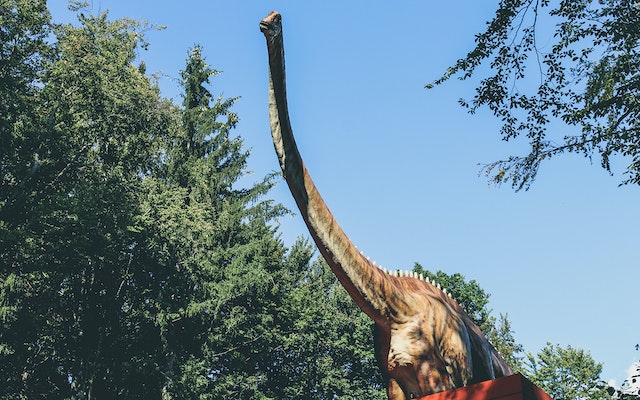
Why did some dinosaurs have such long necks? To reach the higher up vegetation, to get more low-lying vegetation, to expend less energy, and to lose heat.
There are several different types of dinosaurs that evolved long necks. The most famous that we probably all know is the diplodocus. The diplodocus was undoubtedly large. It was probably about 30 m long and their necks might have been 8 m long. That is about 3 times longer than the neck of a giraffe, but diplodocus didn’t have the longest necks. They were members of the sauropod family that were all of a similar shape: long necks, long tails, and four legs. The sauropod with the longest neck (at least the longest discovered so far) was the barosaurus, which had a neck that was 15 m long. The whole animal was probably 48 m long and could have weighed 63 tons.
Before we look at why they had such long necks, let’s look at how. They needed several adaptations to be able to support such a long neck. The first was an equally long tail. In order to balance, they needed a counterweight and that came in the form of a long tail, thinner, but longer than the neck. They also needed hollow bones. Dinosaur bones are constructed in the same way as bird bones, with a hard outer surface and a network of hollow supports inside. This structure makes the bones very strong and very light. Third, they needed small heads. Lifting a weight at the end of a long neck is very hard because it puts more strain on the muscles and vertebrae.The diplodocus’s head was basically just a mouth, teeth, and a tiny brain. Fourth, their muscles and ligaments were positioned to supply leverage, meaning they could lift their necks or keep them horizontal with much less effort. The fifth adaptation was multiple hearts. There is no fossil evidence for this, but it would have been impossible for one heart to pump blood all the way to the dinosaur’s head and back again. Each heart would have pumped the blood to the next heart, and so on. And 6th, they had a system of air sacs, similar to birds. They wouldn’t be able to breathe in the same way that we do because their necks are too long for the air to pass in and out. The air sacs hold the air in sequence and let them get enough oxygen to their lungs.
So, why did some dinosaurs have such long necks? No one knows the actual reason, but there are several theories. The first is that a long neck allowed them to eat vegetation that was higher up. This is one of the arguments used for giraffes as well, but the sheer difference in scale between a giraffe’s neck and a barosaurus’s neck makes it questionable. Would they have needed to reach the top of trees 15 m up? It can also be shown that because their center of gravity was over their rear hips and because most sauropods had very long tails and thick hips, they could have stood up on their rear legs as well. This would have made them even taller. Well, fossils of trees have been found that show the trees in the time of the sauropods might have been up to 50 m tall. If that is correct, then a dinosaur that can reach 20 m into the canopy makes more sense.
Some people think that the sauropods didn’t stretch their necks upwards, but used them to graze from the ground but in a side to side pattern, almost like a long hoover attachment. They ate huge amounts of low-lying vegetation and their long necks allowed them to reach more of it and faster than other animals.
The third theory is that long necks meant the sauropods didn’t need to use as much energy. Every step they took, meant carrying their massive weight, which required a substantial amount of energy. Having a long neck allowed them to reach vegetation up to 15 m away from them in three directions without having to move their bodies. This could imply that they evolved the long necks after they became big, and the long necks allowed them to become even bigger.
The last theory is that a long neck lets the sauropods lose heat. In a similar way to the big ears an elephant has, the long neck would increase the surface area of the dinosaur without increasing its volume much. The ratio of surface area to volume describes how much heat an animal can lose, and the higher the surface area, the more heat they can expel. Dinosaurs were probably warm-blooded, which means they need a way to lose heat. Their long necks could have been that way.
It is also possible that sauropods used their long necks to attract mates and to fight, in the same way that giraffes do, but there is no way of knowing this. And this is what I learned today.
Photo by Creative Vix: https://www.pexels.com/photo/brown-dinosaur-9753/
Sources
https://www.livescience.com/27376-how-dinosaurs-grew-longest-necks.html
https://www.ncbi.nlm.nih.gov/pmc/articles/PMC3628838/
https://edition.cnn.com/2020/11/17/americas/dinosaur-sauropods-long-necks-scn/index.html
https://en.wikipedia.org/wiki/Eusauropoda
https://en.wikipedia.org/wiki/Sauropoda
https://en.wikipedia.org/wiki/Barosaurus
https://en.wikipedia.org/wiki/Diplodocus
https://newatlas.com/science/dinosaur-50-ft-neck-longest-animal/
https://www.livescience.com/24326-diplodocus.html
https://www.dkfindout.com/us/dinosaurs-and-prehistoric-life/dinosaurs/inside-diplodocus/
